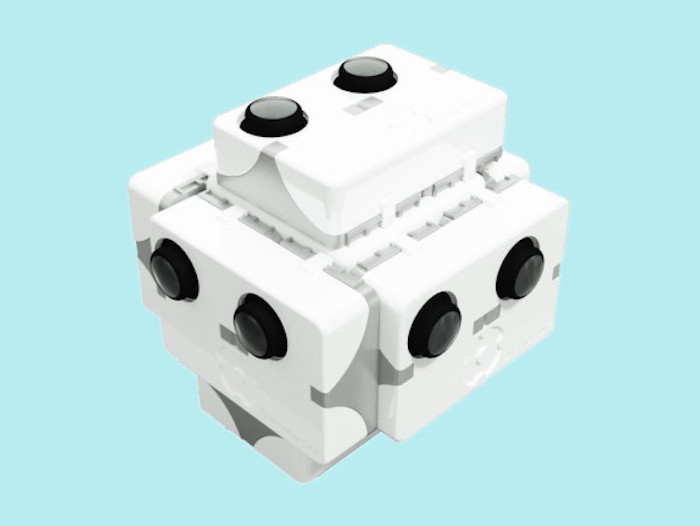.

SpaceVR's Overview One camera is built around a dozen GoPros, but the team had to mod each camera heavily to make the rig space-friendly. SPACEVR
SINCE 1961, ONLY 536 people have been to space. Given that there are 7 billion people alive right now, that’s not a lot. But space tourism is on the horizon and private companies like SpaceX are on the rise. Still, odds are you won’t be going to outer space anytime soon.
A startup called SpaceVR is trying to make it so that you don’t need to. It’s built its own VR camera in an attempt to bring outer space to the masses—essentially, the company wants to become the Netflix of space VR. They want their VR videos to work with any VR platform, too.
The company created a custom-made camera that can hitch a ride on a private cargo expedition to the International Space Station. Their first idea is to mount the camera inside the ISS’s Cupola, the seven-window observatory that will allow the VR camera to look back on Earth.
The 12-camera rig, which the team is calling Overview One, was built around a dozen GoPros. Each will shoot 4K video, stitch the footage together into a VR video sphere, and beam it back to Earth. Which will take a while: It’ll be 624GB of data for every two-hour recording session. The footage won’t be livestreamed in the first-generation camera, but SpaceVR’s co-founders say they want to do live feeds eventually.
“The camera is a handheld camera,” says Isaac DeSouza, co-founder and CTO of SpaceVR. “We envision the astronauts being able to put the camera in places like the Cupola, you just clip it on there. But at the same time, the astronauts are welcome and encouraged to move the camera around, put it in different modules, record different things. Eventually what we want to see is enough footage so we can create 3D models where VR headsets that have positional tracking can take advantage of it, too.”
You can’t just send any old VR camera onto the ISS. Overview One may technically be made out of GoPros, but they had to be heavily modded and tested. The camera has to pass a range of space-qualification tests.
“There’s vibration testing, being able to survive the loads of a rocket launch, something most cameras don’t need to go through,” says DeSouza. “Electromagnetic radiation, if your camera makes certain types of signal noises, it’s scrubbed altogether. And then they’ve got other interesting tests, like the kick test. Any object that floats around freely in the space station has to survive a kick test. And that’s, if the astronaut was moving around in a hurry and he kicked the object, you have to be able to prove that it will not harm him or the space station.”
The technical challenges didn’t end there. Camera lenses are made of glass, and glass can be deadly in space. If glass breaks, it creates airborne particles that can wreak havoc on an astronaut’s lungs if inhaled. DeSouza says his team needed to add a special coating to each lens. They also had to use special batteries for each camera, because zero gravity could affect the stock GoPro lithium-ion batteries. After running the camera for hours at a time, dissipating heat could also be a big issue.
“There’s no convection in space,” DeSouza says. “When it gets hot, it just stays that way. Hot air doesn’t rise. So you have to create forced convection, which can create another problem because the slightest force makes you move in zero gravity. If you turn on a fan, you’ve now got propulsion.” Certain parts of the camera will even be 3D-printed in space thanks to a partnership with Made In Space—this will allow the team to cut costs because the camera will take up less volume and it will also allow them to print some of the delicate parts that could be damaged during launch.
While the hardware is ready and the SpaceVR team has done some test runs in a high-flying balloon, they are turning to Kickstarter to launch the camera into space. While the team wouldn’t disclose the exact ticket price for a flight to space (“We can’t tell you the exact price to send it into space, but it’s under a million,” says SpaceVR co-founder and CEO Ryan Holmes), it’s looking for $500,000 from backers from now through September 10.
According to Holmes and DeSouza, that will cover the costs of getting the camera into space, which is slated to happen in December. The camera hopes to hitch a ride with the Orb-4 and should rendezvous with the ISS on December 6. As for the future of the business, Holmes and DeSouza say they envision a Netflix-style subscription model, through their own platform, that’ll give people access to several new VR experiences a month.
You can even mix their VR experience with a stomach-churning real one.
“For our KickStarter, one of our top rewards is we can do VR in a parabolic flight,” says DeSouza. “The vomit comet. We’ll switch over the feed for when you’re floating around in space in the Cupola, and just when the zero gravity kicks in, you’ll be floating and seeing the Earth. From there, your experience versus the real thing is only a philosophical debate.” It’s amazing what $10,000 can get you.
Quelle: WIRED
4203 Views
